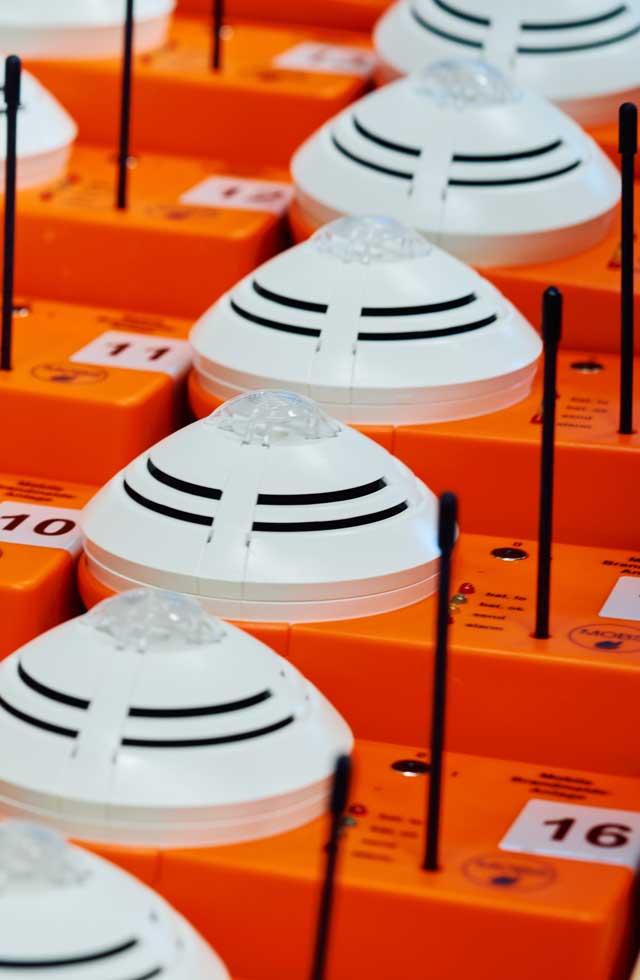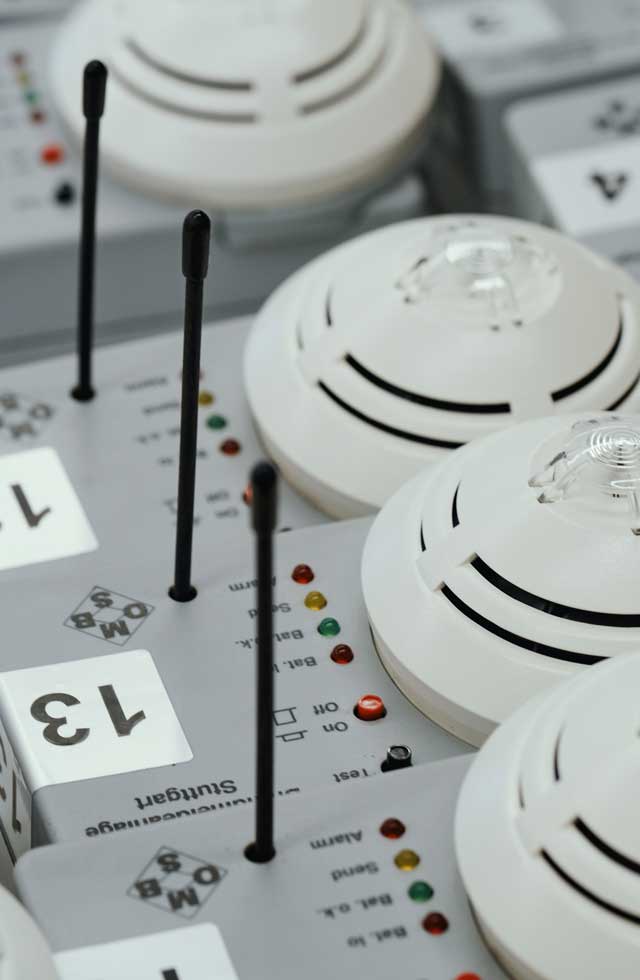With our MOBS mobile fire alarm systems, you have a reliable system for fire alarms and evacuation. This includes temporary fire protection monitoring at building sites, events, historic buildings, shipyards, warehouses, and all manner of operations in different areas. Our systems can also be used where there is no permanently installed fire protection or fire alarm system, such as during renovations, as backups, and in emergencies.
Alarm retransmission
In addition to the on-site alarm, the fire brigade or a security firm might also need to be notified immediately.
MOBS offers various connection methods. We work together to find the right solution for every project:
-
switch contacts for connecting to an existing fire alarm system with the following options:
-
automatic dialer and voice announcement to one or more telephone subscribers
-
automatic dialer and to an emergency call center (NSL) via VdS 2465 -S2 protocol
-
-
professional mobile radio and voice announcement or text message to a patrol (analog or digital)
-
display on the browser-based MyMOBS.de platform
People present are immediately warned and evacuated, and fires detected can be extinguished as quickly as possible.
Note: We do not recommend alarm retransmission via SMS because the delivery time is not guaranteed.
Our standards: even higher!
Even though MOBS doesn’t fall under the standards for permanently installed fire alarm systems and can't be certified according to them, we build and test MOBS based on these corresponding standards. Furthermore, all MOBS components are labeled with the CE marking (CE 0682).
Standards and legal directives of mobile fire alarm systems
Mobile fire alarm systems are not regarded as construction products because they are not permanently installed in a building. They also do not constitute their own product category. System certification for mobile fire alarm systems in accordance with EN 54, DIN VDE 0833, and DIN 14675 is not possible in Germany, although it is occasionally claimed and promised that this will be. Fire alarm systems with radio transmission are considered radio products and are subject to the European Radio Equipment Directive (RED) 2014/53/EU. The requirements for radio systems are regulated by EN 300220 and EN 301489. Their objective and purpose are safe radio transmission.
Do more than meet standards and legal requirements with MOBS
The number of receivers usually assigned to one mobile receiver is 30 to 40 radio detectors, as recommended in DIN VDE 0833. This standard allows a maximum of 32 detectors per system (detector group) in Germany. With our MOBS detectors, up to 63 radio detectors can be connected. MOBS also has a very large range (1800 m open field, 70 – 300 m in a building). The system range can even be extended farther with repeaters. This makes our mobile fire alarm systems even faster to build and more secure against faults while being based on the applicable standards and legal directives.

The fire sensors used came from permanently installed fire alarm technology and correspond to the standard EN 54-5 or EN 54-7 (depending on the sensor used). Our dual optical-thermal fire alarm not only meets the standards of DIN EN 54-5 and DIN EN 54-7, but is also maximally dust- and moisture-resistant due to its two-stage optical sensor. This reduces the number of false alarms, which translates to considerably lower resulting costs!

The right sensor for every application
| Sensors | Example applications |
| O2T: Dual optical-thermal | Building sites |
| O: Optical | Office buildings, industrial halls |
| TD: Thermo-differential | Constant extremely high dust levels |
| TM: Thermo-max | Example applications |
| OTG: Optical-thermal CO gas | Personnel at risk |
| OTB: Optical-thermal blue | Replacement for ionization detector |
| FGM: Combustible gas | Carbonization gases, coal dumps |
| Linear: Light curtain detector | Large halls with poor access |

MOBS mobile fire alarm systems are used in the automotive industry, hospitals, schools, public buildings, and large building sites. They are thus the state of the art in mobile fire alarm systems.
| Mobile fire alarm system | Permanent fire alarm system |
| Directives | |
| according to the Radio Equipment Directive (RED), construction products are not radio products | construction products follow the Construction Products Directive (CPD) |
| Standards | |
| EN 300 220 follows the EN 54 standards | EN 54, DIN VDE 0833, DIN 14675 |
| Set up by: | |
| MOBS Supervisor | in accordance with permissible operation per DIN 14675 |
| What that means for you: | |
| A mobile FACP offers the freedom of being able to implement an economical and practical improvement in fire protection. | There are specific standards that must be followed during planning and installation that are practically impossible to adhere to at building sites. |
The first MOBS mobile fire alarm system was developed in just 1989 as part of a cooperative venture with an insurance company. Mobile fire alarm systems monitor places with a temporary risk of fire, for example, after hot work such as welding, grinding, or tar insulation. It monitors hospitals, historic buildings, and industrial sites to protect people and buildings. Close contact with customers, constant development of our solutions, and acquiring ever greater market shares are particularly important to our main area of business today.







